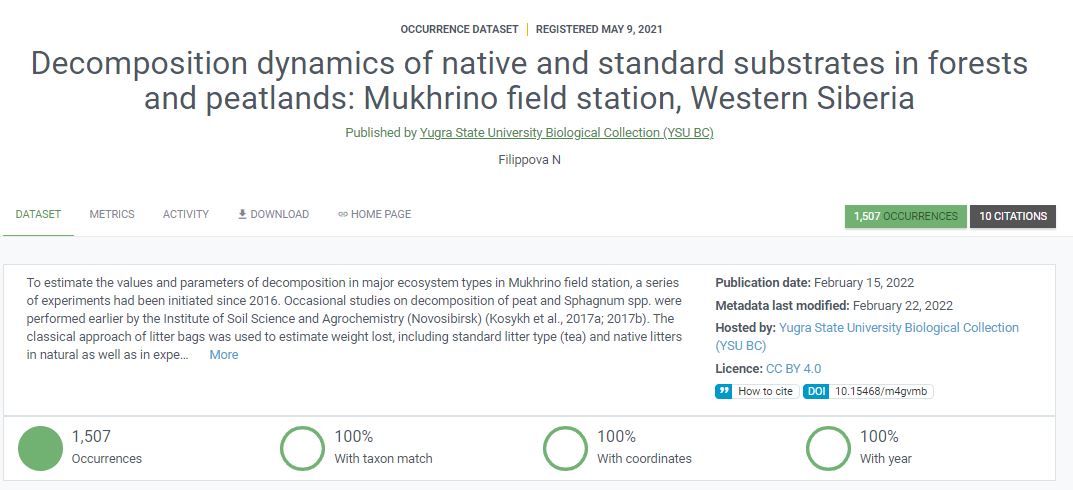To dynamics and parameters of decomposition in major ecosystem types in Mukhrino field station, a series of experiments had been initiated since 2016. Occasional studies on decomposition of peat and Sphagnum spp. were performed earlier by the Institute of Soil Science and Agrochemistry (Novosibirsk) (Kosykh et al., 2017a; 2017b). The classical approach of litter bags was used to estimate weight lost, including standard litter type (tea) and native litters in natural as well as in experimental warming conditions (temperature manipulation by Open Top Chambers). The standard tea substrate was used to compare habitat effect and as part of the global projects on decomposition dynamics, where two different tea types were used to estimate decomposition constant from only one extraction point (Keuskamp et al., 2013; Djukic et al., 2018; MacDonald et al., 2018). To estimate the natural values of decomposition, eleven types of native substrates were chosen.

Totally 3850 bags (native and standard litters) were installed by November 2023. To date, 2387 bags have been extracted and the data about mass loss are available.
The decomposition of native litters is studied in three plots, located in major vegetation types: treed Pine-dwarfshrubs-sphagnum bog (ryam), graminoid-Sphagnum bog (lawn) and coniferous forest. Each plot is represented by two replicas to cover spacial variation. Each replica contains four bags of a particular litter types buried for a particular period. The series of bags for 1-4 year of decomposition are buried each year since 2016 (totally 7 installations were made by 2023) and will be continued in the future.
The decomposition of standard (tea) substrate was studied in the same plots as native substrates. To supplement the variety of vegetation, another three plots were located in deciduous forest types after clear-cut: 10 years and 40 years after the clearing, and in the nearby old-growth coniferous forest. To study long-term dynamics of standard substrate, a series of bags for 1-4 years of decomposition was located only once in 2016. The decomposition experiment of standard litter (tea) was performed according to (Keuskamp et al., 2013). A batch of calibrated tea was used (bought from Sweden) to standardize the substrate across the global experiment span. c. The extraction was made about 3 month later, in the beginning of September with the onset of first frosts. Besides, one series of long-term decomposition bags of standard tea (3 months, 1, 2, 3, 4 years) was installed once in 2016.
The decomposition experiment of native litters was made according to instructions in (Keuskamp et al., 2013) for native litter bags preparation. The leaves of native plants were collected in Autumn after beginning of leaf fall, dried and sewed into nylon bags 10 x 10 cm (mesh size about 0.2 mm), labeled and buried in the upper 0-5 soil horizon.
After the incubation period, litter bags of native and standard types were excavated from the soil, cleaned from attached soil and roots and dried. The substrates were cleaned from roots with the help of lens, when possible (when difficult to clean, this was marked in the database).
Bibliography
- Kosykh, N.P., Vishnyakova, E.K., Koronatova, N.G., Sayb, E.A., Filippova, N.V., 2017a. Production and destruction processes in oligotrophic hollows in the muddle taiga (OTC-experiment) [Продукционно-деструкционные процессы в олиготрофных мочажинах средний тайги в OTC-эксперименте], in: Углеродный Баланс Болот Западной Cибири в Контексте Изменения Климата : Материалы Междунар. Конф. (Ханты-Мансийск, 19–29 Июня 2017 Г.). pp. 77–79.
- Djukic, I., Kepfer-Rojas, S., Schmidt, I.K., Larsen, K.S., Beier, C., Berg, B., Verheyen, K., et al. 2018. Early stage litter decomposition across biomes. Science of The Total Environment 628–629, 1369–1394. https://doi.org/10.1016/j.scitotenv.2018.01.012
- Keuskamp, J.A., Dingemans, B.J., Lehtinen, T., Sarneel, J.M. and Hefting, M.M., 2013. Tea Bag Index: a novel approach to collect uniform decomposition data across ecosystems. Methods in Ecology and Evolution, 4(11), pp.1070-1075
- Filippova N.V., Glagolev M.V. 2018. Short-term standard litter decomposition across three different ecosystems in middle taiga zone of West Siberia // IOP Conf. Ser.: Earth Environ. Sci. V. 138. № 1. P. 012004. http://iopscience.iop.org/article/10.1088/1755-1315/138/1/012004/meta
- Filippova, N.V., Glagolev, M.V. 2019. Short-term standard litter decomposition across three different ecosystems in middle taiga zone of West Siberia. Tea Bag Index symposium 2019 Umeå, 20 and 21 February 2019. https://doi.org/10.13140/RG.2.2.17937.79201
You are welcome to visit a photoalbum on Flickr for pictures of plots, installation and extraction process.
